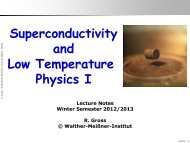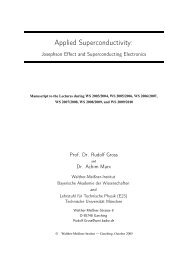Design, Fabrication and Characterization of a Microwave Resonator ...
Design, Fabrication and Characterization of a Microwave Resonator ...
Design, Fabrication and Characterization of a Microwave Resonator ...
You also want an ePaper? Increase the reach of your titles
YUMPU automatically turns print PDFs into web optimized ePapers that Google loves.
2 Theoretical Description <strong>of</strong> a CPW<strong>Resonator</strong>The aim <strong>of</strong> this thesis is to design a resonator for frequencies in the GHz-regime fabricatedin coplanar waveguide (CPW) technique. This chapter deals first with the theory <strong>of</strong>CPWs based on the conformal mapping method [16]. The calculation <strong>of</strong> the characteristicimpedance, capacitance <strong>and</strong> inductance <strong>of</strong> a CPW is discussed in detail. Then we brieflypresent how the use <strong>of</strong> different substrate materials influences the characteristics <strong>of</strong> the CPW.At the end <strong>of</strong> the first section, the dispersion <strong>and</strong> attenuation aspects are given.After this, effects <strong>of</strong> using a superconducting material (in our case Niobium) on theimpedance <strong>and</strong> attenuation are introduced.The third part <strong>of</strong> this chapter discusses some basic details <strong>of</strong> resonators, especially resonancefrequency, quality factor <strong>and</strong> coupling to the environment. The special cases <strong>of</strong>microwave <strong>and</strong> superconducting resonators are presented. The attenuation considered in thefirst section is extended to superconductivity <strong>and</strong> the temperature dependence <strong>of</strong> resonancefrequency <strong>and</strong> quality factor <strong>of</strong> the superconducting CPW (SCCPW) is discussed.The last section explains briefly the theory <strong>of</strong> scattering parameters used in our measurements.2.1 The Coplanar Transmission LineThe CPW proposed by C. P. Wen in 1969 [22] was chosen for this thesis for its easy fabricationcompared to other types <strong>of</strong> transmission lines. The conducting layer is directly fabricatedon top <strong>of</strong> a substrate without the need for wraparounds or via holes. This means, onlya single layer technology is required, therefore, the CPW can be fabricated in-house at theWalther-Meißner-Institut. Another advantage is the very small radiation loss which wouldinfluence the quality factor <strong>of</strong> the resonator. Furthermore, the characteristic impedance isdirectly related to the ratio <strong>of</strong> the width <strong>of</strong> the inner strip to the width <strong>of</strong> the gap, so it waspossible to design various geometries easily. In this thesis three different designs were realized.Taking superconductivity into account, with the so called kinetic inductance, onecan see from Figure 2.8 in subsection 2.2.1 that the CPW is not very sensitive to the kineticinductance.This section deals with two classifications <strong>of</strong> CPWs, shown in Figure 2.1. The usedequations <strong>and</strong> further information can be found in reference [18]. A conventional CPW on adielectric substrate consists <strong>of</strong> a center strip conductor with semi-infinite ground planes oneither side. However, in a real circuit the ground planes are large but <strong>of</strong> finite extend. Theconductor backed CPW (CBCPW) has an additional ground plane at the bottom surface <strong>of</strong>the substrate, realized by sputtering Niobium on both sides <strong>of</strong> the substrate.3
















